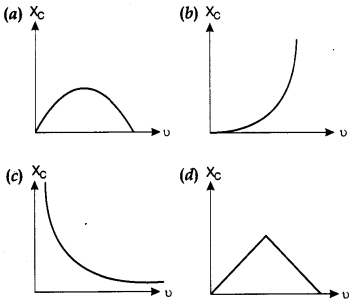In This Post we are providing Chapter-7 Alternating Current NCERT MCQ for Class 12 Physics which will be beneficial for students. These solutions are updated according to 2021-22 syllabus. These MCQS can be really helpful in the preparation of Board exams and will provide you with a brief knowledge of the chapter.
NCERT MCQ ON ALTERNATING CURRENT
1. Alternating voltage (V) is represented by the equation
(a) V(t) = Vm eωt
(b) V(t) = Vm sin ωt
(c) V(t) = Vm cot ωt
(d) V(t) = Vm tan ωt
Answer: b
2. The rms value of potential difference V shown in the figure is
Answer: c
3. The phase relationship between current and voltage in a pure resistive circuit is best represented by

Answer: b
4. In the case of an inductor
(a) voltage lags the current by π2
(b) voltage leads the current by π2
(c) voltage leads the current by π3
(d) voltage leads the current by π4
Answer: b
5. Which of the following graphs represents the correct variation of inductive reactance XL with frequency u?
Answer: b
6. In a pure capacitive circuit if the frequency of ac source is doubled, then its capacitive reactance will be
(a) remains same
(b) doubled
(c) halved
(d) zero
Answer: c
7. Which of the following graphs represents the correct variation of capacitive reactance Xc with frequency v u?
Answer: c
8. In an alternating current circuit consisting of elements in series, the current increases on increasing the frequency of supply. Which of the following elements are likely to constitute the circuit?
(a) Only resistor
(b) Resistor and inductor
(c) Resistor and capacitor
(d) Only inductor
Answer: c
9. In which of the following circuits the maximum power dissipation is observed?
(a) Pure capacitive circuit
(b) Pure inductive circuit
(c) Pure resistive circuit
(d) None of these
Answer: c
10. In series LCR circuit, the phase angle between supply voltage and current is
Answer: a
11. In a series LCR circuit the voltage across an inductor, capacitor and resistor are 20 V, 20 V and 40 V respectively. The phase difference between the applied voltage and the current in the circuit is
(a) 30°
(b) 45°
(c) 60°
(d) 0°
Answer: d
12. At resonance frequency the impedance in series LCR circuit is
(a) maximum
(b) minimum
(c) zero
(d) infinity
Answer: b
13. At resonant frequency the current amplitude in series LCR circuit is
(a) maximum
(b) minimum
(c) zero
(d) infinity
Answer: a
14. Quality factor and power factor both have the dimensions of
(a) time
(b) frequency
(c) work
(d) angle
Answer: d
15. The natural frequency (ca0) of oscillations in LC circuit is given by
Answer: c
Discover more from EduGrown School
Subscribe to get the latest posts sent to your email.
